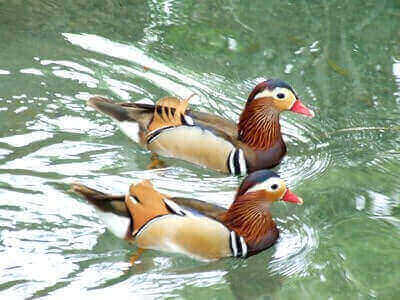Disclosure: We may earn commissions if you purchase products after clicking on a link from our site.
Are you looking for the best duck hunting tips to improve your hunting? Do you want to take your duck hunting to the next level? Would you like to take more ducks home? We have researched and compiled this list of duck-hunting tips to help you become a better duck hunter.
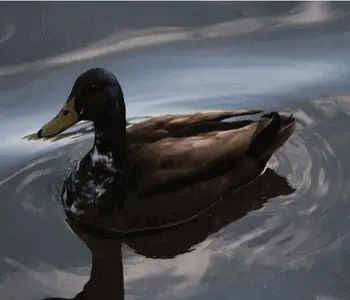
Best Duck Hunting Tips
1. Duck Decoys & The Wind
When you set up your duck decoys, you can set them up any way you like. The only caveat is that you leave an open area for the birds to land in the wind. When birds descend for a landing, they will have to come down into the wind.
2. Boat Camouflage
Use natural vegetation to camouflage your boat. Using a stretch cord, line the sides, bow, and stern of the boat with sections of the cord that are a foot apart and held in place with four penny nails, screws, or pop rivets. To conceal the outline of the boat, weave vegetation like cattails, bulrushes, or cornstalks between the cords. – Turner Wilder, Grantham, New Hampshire
3. Your Guide’s Advice
While you are waiting for ducks, your guide will tell you to stay down, keep your head down, and not watch the birds instead he will do the watching. Your blind should be built so that you can watch the birds just like your guide. You shouldn’t have to look skyward when the ducks are passing right overhead as this will spook them.
4. Water Holes In Frozen Marshes
A good late-season hunting duck tactic is to create open water holes in frozen marshes and lakes. Break ice into large sheets if that is possible. Then neatly push them under the ice to create an open hole. If the ice is too thin to break up into solid chunks, use a large landing net. Pick up the floating pieces of the broken ice with the landing net by sweeping the water’s surface.
However, if the ice is too thin to break up into sheets, you can use a heavy ax to create a 3 x 3-inch hole. While you are standing in the hole, use your boots to stir up the bottom sediments and kick up muddy water on the ice. This creates the appearance of open water. Put silhouette or shell decoys on the muddy water to create the illusion. You may have to kick up new water onto the ice regularly on very cold days.
5. Circling Your Decoy
Pintails, Widgeons, Gadwalls, Blacks, and Mallards like to circle a decoy set a couple of times before they come in. There are always two or three birds that will leave the flock and pass in a nice shooting range. Don’t hesitate; shoot them down. Don’t be bothered with the flock, according to Ray P. Holland.
6. Late Duck Hunters
Waterfowls like to take advantage of strong tailwinds by migrating with or slightly behind cold fronts. Don’t leave your hunting blind early on good migration days. The best duck hunting happens late in the morning when birds stop for a respite. To find the best hunting ground blinds, we did a review of ground blinds that you can read from this link.
7. Local & Distant Birds
Learn to recognize local birds that you hunt early in the season from the birds that migrate later on. Local birds will be in pairs and small flocks. Decoy them and don’t overhunt one spot. The big spreads will come in handy when the birds from the north arrive.
8. Decoy At A Crossing Angle
Many duck hunters like to hunt with the wind behind them and their decoys set in front of them. This setup makes the duck look directly into the blinds as they approach, thereby increasing the chances that the ducks will detect movement. Additionally, this makes follow-up shots more difficult and increases the chances of crippling the birds as they quickly flair downwind from you when shots are fired.
9. Canvasbacks Are Number One
The canvasbacks are the number one ducks for a duck hunter. It is the hardest duck to hit as they are very fast when they fly with its powerful wings.
10. Duck Loads vs Goose Loads
Many duck hunters take along both duck and goose loads to the blind. With us, sometimes the printing on the cartridges gets worn off. This makes it illegible and difficult to tell which shot size is in the shells. One way to remedy this situation is to use a black magic marker and write the shot size or letters on the end of the brass casings on all of the shells. This helps you quickly identify and choose duck or goose loads when they are in the loops of the hunting vest. You can read about the best goose hunting tips in this article.
11. Scouting A Pothole Or Small Pond
If you have been monitoring a pothole or a small pond and intend on shooting the ducks that are there, move in on them with the wind at your back. When they jump into the wind, you will have a good chance to get a shot off before they re-orient themselves and fly away.
12. Hunting On Calm Days
Stationary decoys sitting in an open hole spook late-season ducks. If you are hunting on calm days, set up your decoys in thick brushy cover and call out to bring in the birds. When the birds are circling in, they will get a brief glimpse of your decoys and when they get close enough to get a good look at your decoys, it will be too late and you will have an opportunity for a good shot.
13. Decoy Variety
Adding other decoys like bluebills or canvasbacks to your decoy setup of gadwalls, widgeons, blacks, pintails and mallards will give your spread more visibility. It will only improve your chances. This is one of the best duck hunting tips to implement.
14. Don’t Flush Out Ducks
Many duck hunters make the mistake of flushing ducks off a roost in the dark before dawn. If you don’t flush them out, the ducks will fly out to feed at the first sign of light and then come back to roost later in the morning. Instead of spooking the birds in the dark, wait until sunrise or later before you set up. You may have more opportunities when the birds return in smaller groups although you might miss out on some in the early morning.
15. Setting Out Decoys With Gloves
When you set out your decoys, use gloves that stretch close to your elbows and keep your hands dry. Then when you are back in your hunting blind, put on your regular gloves.
16. Wind Direction On Mornings With Light Breeze
It goes without saying that knowing the wind direction is very important to positioning decoys and blinds in the fields. On mornings with a light breeze, it might be very challenging. To resolve this problem, take a small squeeze bottle of talcum powder with you on your hunt.
Squeeze the bottle a few times and observe the direction the talcum powder drifts toward before you set up your decoys. The drifting talcum will show you the direction in which the light breeze is blowing.
17. Difficult Shot
When you are in hunting blind, can’t see the ducks, and are waiting for the command from your guide to take the shot, it will be a difficult shot to take. You will have to come up with your firearm, and look for and find the birds before getting down to pointing and swinging the barrel. That will make it a difficult shot to execute. A hunting blind that allows you to see the birds is worth its weight in gold.
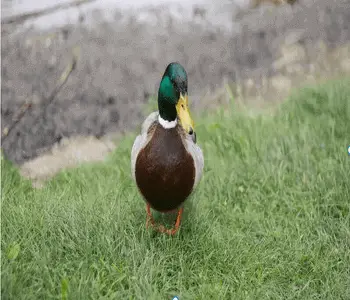
18. Adjusting Decoy Line
Adjusting the decoy line for different water depths can be very challenging. One way to solve this problem is to attach a metal shower curtain rung to large fishing swivels on the keels of your decoys. When you set your decoys, unwrap the line of the keel to the desired depth, open the curtain rung, place the line inside the rung, and snap it shut. This will keep the line from coming off the keel.
19. Hunting Gadwalls
According to Ray P. Holland, author of Scattergunning, he states that will circle and circle when they working on your decoy. Stay in position, keep your head down, and don’t move. Wait for them to come in range when they are ready. That’s when you take the shot.
20. Camouflage Patterns On Boats & Blinds
You can use a stencil for painting camouflage patterns on boats and blinds. The stencils can be made out of dry-erase poster boards. Place pieces of leaves, tree branches, and cattails on the poster board and trace them around them with a fine magic marker. Then cut out the outlines to create a stencil.
To paint it, hold the poster board up against the surface of your boat or blind and spray paint over the holes. You can create a highly realistic custom camouflage pattern that will match any type of vegetation and background by overlapping different shapes and using different colors.
21. Jump-Shooting Ducks
A great way to hunt creeks and small rivers is jump-shooting ducks from a canoe or john-boat with a hunting partner. One hunter should be paddling while the other has the gun ready to take the shot. Be quiet and ready to take the shot at short notice. Be prepared for sharp bends where you may suddenly come upon blacks, mallards, or other puddle ducks. Always be listening carefully as you may hear the birds before seeing them.
22. Cross-Country Ski Poles
As you go about setting out and picking up decoys in the marsh, you can use cross-country ski poles to help you keep your balance. You will benefit from stability with the ski poles, thanks to the six-inch diameter baskets at the base of the poles. They also prevent the ski poles from sinking in the mud.
Moreover, the loops on the handles will keep the ski poles secured to your wrists thereby freeing your hands to work with your decoys and complete your tasks. The ski poles will also allow you to extend your reach to pick up downed birds and decoys in deep waters. They can also be used as supports to hold up camo netting and natural vegetation as a makeshift blind.
23. Don’t Mistake Movement For Blind
When ducks are working toward your decoys and suddenly decide to fly away, it was your movement that spooked them, not your hunting blind.
24. Key Caddy
You can easily solve the problem of not losing all of your keys while duck hunting by putting all of them on a floating foam key ring that can be purchased at a boating supply store. It keeps all of your keys in one place and also makes it easy to recover them if dropped in the water or on the ground in the dark.
25. Visibility of Decoys
Most of your duck-hunting areas should be in open areas where birds can easily see your decoys and come in. It is all about increasing the visibility of your decoys. Black decoys show up better from some distance and the magnum size gives visibility. Additionally, Canadian geese decoys give visibility, whether you are hunting for geese or not.
26. Hunting In Snowy Conditions
Duck hunters usually camouflage well in snowy conditions by wearing a white jacket, coat, gloves, and ski mask. What many of them don’t camouflage is their weapon. Shotguns are more visible to ducks and geese against a white background.
Wrapping your shotgun in white medical gauze is an inexpensive and effective way to camouflage your weapon and conceal it from the birds.
27. Double-Barreled Guns In Blinds
Double-barrel guns have limitations when hunting ducks. It has a two-shot limit and is considered an issue as duck hunters prefer three shots. Additionally, double-barrel guns must be broken open for feeding which can be cumbersome in the hunting blind.
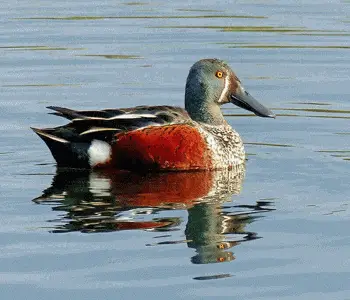
28. Cleaning Dirty Duck Decoys
Hang dirty duck decoys on a fence and spray paint them with an automobile tire cleaner solution and allow them to dry overnight. In the morning, the original colors will shine brighter and will be easier for the ducks to spot.
29. Great Blue Heron Decoy
Many waterfowl market hunters like using the great blue heron decoy when hunting. The Heron is a wary bird that is noted for not allowing anything to approach it very closely. Hence, the old-time waterfowl hunters considered a Heron decoy in their spread as a confidence booster.
30. Unsinkable Decoy Bag
To prevent losing your decoy bag, tie a plastic, 16-ounce soft-drink bottle inside the bottom of the bag. Remove the label to get rid of bright colors and screw the cap down tight.
31. Maine Sea Duck Hunting
Duck hunting in the Maine Sea, with its freezing rough water and rocky coasts of rough and pounding surf, can be risky. However, it is a great hunting location for eiders, scoters, and assorted puddle ducks.
32. Feeding Duck Ruse
Run a nylon cord from the blind through the eye of a heavy anchor connected to a decoy in the center of the spread. Then tie the line to the bill of the decoy floating over the anchor. When the ducks are in the range of your decoys, tug on the line to mimic a feeding duck with your decoy.
33. Hunting Bluebills
The best time to hunt bluebills is the high mark of the year. It flies with great speed and is a good sporting target. Bluebills are very receptive to decoys and love company. It will not hesitate to come on into your spread with a lot of confidence and eagerness. Additionally, it is good to eat according to Jimmy Robinson from the “Rockets of the North”.
34. Flag Pole Tactic
You can draw the ducks’ attention to your decoy spread by using a telescoping, fiberglass fishing pole for raising and working a goose flag or kite.
35. Magnum or Super-Magnum
Visibility should be your primary objective with your decoys. The visibility of your spread is enhanced with oversized decoys. Whether to use magnum or super-magnum comes down to whether you gave more weight to visibility or the ability to carry the decoy. More magnum decoys can fit in your hunting bag than super-magnum decoys.
36. Muddy Water Trick
If you are hunting in clear water, muddy the water around your decoys using your feet. The activities of ducks produce muddy waters and a muddy zone is easily spotted by ducks.
37. The “Hole” of The Decoy
Regardless of the shape of your decoy spread, it must have a hole or two for the birds to come on in. The birds will land on the outside of the spread at long range or even out of range if the water in front of the blind is solid with decoys.
38. Shopping Basket
Get an old-fashioned shopping basket to make a storage box for dead ducks. Camouflage it with paint so the birds won’t notice it. Put the dead birds in it to prevent them from freezing on your boat on very cold days.
39. Waterfowl Hunting
You have to hunt for ducks that are flying, feeding, or resting. You have to set up where you have seen them before or where they are if you want to get them.
40. No Retrieving Dog, No Problem
If you are duck hunting a pond or stream too deep for wading and don’t have a retrieving dog, take along a casting rod and a floating plug. You can fasten the ducks to the casting rod and retrieve them. You can learn how to train your hunting dog in this article.
41. Dangers of Duck Hunting
Waterfowl hunting is not for the fainthearted. It is challenging and dangerous in certain situations and conditions. You have to factor in swift waters, big bodies of water, the wind, rain, ice, and fog. If you are a senior or disabled, seriously consider a hunting partner. It’s a safer bet.
42. Crow Decoys
You can increase the chances of success when duck hunting by putting a few crow decoys to one side of a field spread for geese. These decoys make the spread more lifelike and reduce the wariness of geese.
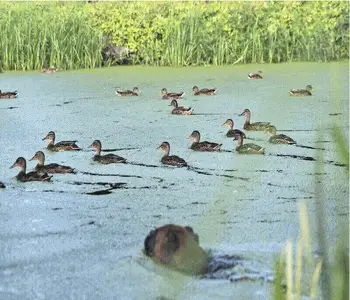
43. The Outer Gun
The key position when hunting ducks is the outside shooter on the upwind side of the duck blinds or lay-out blind setup. If he starts shooting too early, around the corner, the guns in the center and on the other side will get no shots. The ducks come into the decoy and spread against the wind from his side.
The outside shooter can ruin or make the hunting. Always put an experienced shooter in that position who has the judgment and poise to wait until the birds are in the spread for everybody to have a good shot at them.
44. Panty Hose For Taxidermy Duck
If would like for a taxidermist to mount a special duck, take along a pantyhose. When you get the duck, rinse the blood off its feathers and then place it, head-first, in the pantyhose. All the feathers will be kept in place in the pantyhose for a good mount by the taxidermist.
45. Early Morning Mallard Hunt
Don’t be surprised if you see any mallards flying about early morning. It is possible that they will show up later in the morning. You may find local birds and others from the north that will be feeding in the fields.
46. Finding Leaks In Waders
To spot a leak in your waders, turn off all the lights and put in a drop cord light inside the waders. The lights inside the waders will glow through any cracks making them easy to be spotted and fixed.
47. When The Season Goes On
Ducks tend to fly higher and higher as the season goes on. This will prompt you to keep adding decoys to your spread to attract ducks. This is something you will learn as a duck hunter with time.
48. Dazzle Your Decoys
You can use blue prism tape to make the speculums on your mallard decoys more dazzling. Paint the speculum patch white and when the paint dries, apply the blue prism tape. This enhancement can lure in decoy-shy birds those final few yards.
49. Where To Set Up
If in the pre-dawn light, while you move along a big river or push into a cove in the marsh, you come upon ducks or geese that move away, don’t follow them or look for another spot. Set up right there. That’s the place to be, don’t make the mistake. It’s just the place the birds want to be.
50. Drake Decoys & Vaseline
Repel dirt and water from your drake decoys by rubbing Vaseline on the heads of your decoys. It adds that extra sheen to your decoys which makes them more attractive to “lookers”.
51. Diving Ducks or Puddle Ducks
Nothing is more thrilling for a duck hunter than the sight of a big flock of ducks sweeping into your decoys. If you know if they were diving ducks from puddle ducks, you will do better when shooting. Diving ducks, like bluebills and canvasbacks, will bore straight past when you start shooting while puddle ducks, like mallards and pintails, will bounce skyward as if they bounced off a trampoline.
52. Call To Tips & Tails
Don’t call when ducks are flying toward you. Old-timers have a saying: “Call only to tips and tails.” This implies that you call when you can only see one wingtip and the tail, or both wings and the tail. When you see the tips and tails, the duck won’t be looking your way which makes it safe to call.

53. Tall-Timber Trick
Imitate splashing and feeding activity by giving the water a kick when birds are passing or circling when you gun the hole in the tall timber with a few decoys out.
54. “Flasher” Decoys
The “flasher” decoy attracts the attention of the ducks that are flying high and wide off your decoy spread.
55. Ducks On Their Way In
When you have gotten the attention of a passing flock of birds with your calls, and they are on their way in, there are two schools of thought about what you should do next with your call. One states that you should cease all calling and let them come on in while the other states that if you have been doing the feeding chuckle, continue doing it as they come on. Stopping the feeding chuckle might spook them.
56. Wear A Face Mask
If you are using layout blinds in duck and goose setups, wear a face mask or apply camouflage makeup to prevent your face from shining like a neon sign to the incoming ducks.
57. Plugging The Gun
Many duck hunters tend to forget to plug pumps and autos into three slots because they didn’t check their guns properly. This is one of the most frequent waterfowl hunting violations.
58. Fetch The Duck
If you hunt ducks on big waters without a dog, take with you a spinning rod and a big surface plug. You can retrieve down ducks by casting the big plug a long way to retrieve down ducks.
59. Your Calling & Guide
Don’t hesitate to inform your guide that you want to do the calling if you have been hard at work practicing your calling. Don’t allow the skillful guide to preventing you from calling when you are in the area and ducks are flying.
60. Shooting Ducks in The Decoys
If you are shooting ducks in the decoys, then you may desperately want to shoot a duck to let the incomers land in the decoys and then go after them.
61. Dangers To Your Dog
Make sure to remove stubs of stumps, long splinters, and deadwood that may be floating just beneath the surface of the water in front of your hunting blind. Dogs like to leap into the water and this may pose a serious danger to your dog.
62. Shot Hitting The Water
If your shot string hits the water behind a low-flying duck, it may not be that you shot behind it. It could have been right on target just a little too high.
63. Different Types of Decoy Setup
Rick Nemecek stated that he doesn’t believe in the standard decoy patterns like a J-Hook or U. He thinks those decoy patterns have become familiar to ducks who see them almost every day. He prefers to set his stall in small family clusters with three to six decoys per cluster. It may still be a J or U pattern, but it is loose. They don’t run together to form long strings.

64. The Magic of Bird Calling
Don’t underestimate the effect of bird calls. It works and should be mastered and used but you should also not overuse it in hunting ducks. Flasher movement decoys are very effective in the early season but not as effective in the late season on down the flyways when ducks have seen them in many decoys spreads according to experts. Some hunters think the flashers spook ducks.
65. Early Morning Pothole Strategy
You have a chance to get a shot at ducks when they are on a pothole early in the morning. You can get to the pothole before they leave or you can get a shot past shooting as they fly over on their way to the fields. To get a shot while they fly over will depend on your scouting abilities.
66. Lead Ducks
One good strategy is to shoot ahead of the ducks. Most ducks are missed by not leading enough. This strategy works like a charm and is one of the best duck hunting tips to implement.
67. Black Duck Decoys
Rick Nemeck states, in the book Decoys and Proven Methods for Using Them, that after talking to biologists who fly aerial waterfowl surveys, he was told the first thing the biologists observed when they saw ducks on the water was their black profiles. Hence, he concluded that the early-season decoy spread will include one-third to one-half of black duck decoys. He also mentioned that biologists also see white profiles.
Therefore, he sets two or three pintail drakes in his decoy spread. As a result, his early-season spread of eighteen decoys includes seven or eight black ducks, three pintail drakes, and the rest mallards. Later in the season, his decoy spread of thirty-six decoys including twenty-four black ducks, three pintails, and nine mallards.
68. Winning The Public Ground Game
Finding more spots that don’t have much pressure on the ducks will result in you getting more ducks. Ducks quickly figure out blinds on public hunting grounds. Only use about half a dozen decoys and only call to get the interest of passing birds. You can learn how to deer hunt in ground blinds from this article.
69. Picking Up Duck Decoys
There are a couple of ways to pick up your duck decoys without leaning out of the boat. You can cut a notch in the blade of a paddle. Then hook onto the decoy anchor line and lift. The other option is that you can create a special hole from a 5- to 7-ft dowel rod with a metal hook screwed into the end.
70. Silhouette Decoy Hole Punch
It is easier to put out silhouette decoys on the hard or frozen ground by using a hole punch.
71. Ducks Come Into The Wind
When you plan your blind location and decoy setup always set up with the knowledge that ducks and geese will land into the wind no matter the strength of it. They always come into the wind.

72. Duck Hunters Discouragement
The major issue that duck hunters have to grapple with is finding a good place to hunt. It is not easy finding a good place to hunt ducks. You just might realize that it is a lot easier to hunt geese.
73. Jump-shooting With No Boat
You can jump-shoot small streams and creeks without the use of a boat. It all depends on you stalking the banks quietly and getting within range of puddle ducks.
74. Ducks & Sandbars
When you scout for locations where ducks are present, if you see birds dropping down over the trees in a bend in the river, that’s where you want to set up. You should also keep an eye open for sandbars on the edges of shallow water in calm bays and coves.
75. Freelance Duck Hunting
Freelance duck hunting is easier today with the development of “mud motors” and portable boat blinds like Avery. You can carry your john-boat on a trailer to where you can find ducks. Scout in the afternoon for duck locations or spots along a flyway where they might be crossing the next morning on their way to feed or loaf.
76. Don’t Be A “Skybuster”
The most hated person on a field or marsh where there is goose or duck hunting is the “sky buster”. He takes shots at birds that are out of his shooting range resulting in frightening the birds away from the area and ruining the chances for other duck hunters with incoming birds.
77. Late Season Timber Strategy
Late in the hunting season, ducks will be in little openings in the thick, brushwoods in the area when they are wary. Don’t use more than 15 decoys plus your shakers. Make one short highball on their first pass and then shut up and let the ducks work on their own.
Once you have made your presence known, don’t call anymore. This is the biggest mistake made in flooded timber according to Arkansas Guide George Cochran.
78. Foggy Morning Timber Hunting
Fog equates to lousy duck hunting. But in timber hunting where there is bright sunny weather, double and triple that. Most likely because ducks see the decoys in the open pools in the trees but can’t see you standing in the shadows. The article how to hunt from a treestand gives you tips and insights into hunting deer from a treestand.
79. No Longer Only Wood Ducks
Some time ago, only the local ducks were wood ducks. Mallards and other ducks were visitors from the North. Things have changed and now mallards and other puddle ducks are found in those areas in the summer.
80. Use Tiny Digital Cameras
One good tactic is to attach a tiny digital camera to the same lanyard on which you hang duck calls and dog whistles. This will have it at your fingertips to capture the action at a moment’s notice.
81. Add Decoys To Your Jump-shooting Boat
Don’t forget to take along a few decoys when you are going for jump-shooting. If you are seeing a number of birds on the move, especially on a braided river, it just might be a good opportunity to put out some decoys, wait and see if they will pull in some ducks.
82. Ducks Are Hard To Hit
According to Ray P. Holland in his book Scattergunning, ducks are harder to hit than other birds because they are taken at longer ranges, fly faster, the shots come at more angles and their protective feathers make it harder to kill them.
83. Pushing Your Luck With Decoys
You might think that positioning your decoys closer to the hunting blind so you can have easy shots is a good idea; it isn’t. The truth is you won’t be getting any shots. Instead, put the closest decoys at least 30 yards from the blind and the others farther out.
84. Bluebird Days
When it’s a “bluebird day”, that is, when there’s not a cloud in the sky or a breath of wind blowing even when ducks are moving, it can be difficult to get their attention. These are the days when you want to use battery-driven shaker decoys and jerk strings attached to some of your decoys.
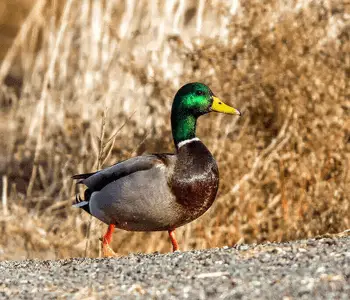
85. Perfect Scenario
The ideal duck hunting opportunity is to be in your duck blind before daylight, with your decoys set up, on a frosty morning without cloud cover. As you watch the stars disappear, you might see birds flying, heading out to their feeding grounds, or being spooked by other hunters nearby.
86. The Wind With Your Decoy Spread
Even when your decoy spread has a hole, ducks prefer to land outside a spread of decoys. This is the reason why you should set up your decoys upwind and not directly in front of the blind. This will allow you to take a good shot at the birds coming in against the wind and trying to land on the outside of the decoy spread. I learned this the hard way and it works. It is one of the best duck hunting tips to implement,
The Bottom Line
The best duck hunting tips will elevate your hunting to the next level. If you want to take more ducks home, then these duck-hunting tips will come in handy on every hunting trip you make. Whether you are looking for duck hunting tips for beginners or you are an experienced duck hunter, these hunting tips will get you more ducks. It is our hope that you find some gold nuggets among these hunting tips that will be useful to you.
Additionally, if you hunt elk, this article on the best elk hunting tips can help you become a more successful elk hunter. Mule deer hunters can also benefit from the best mule deer hunting tips.
